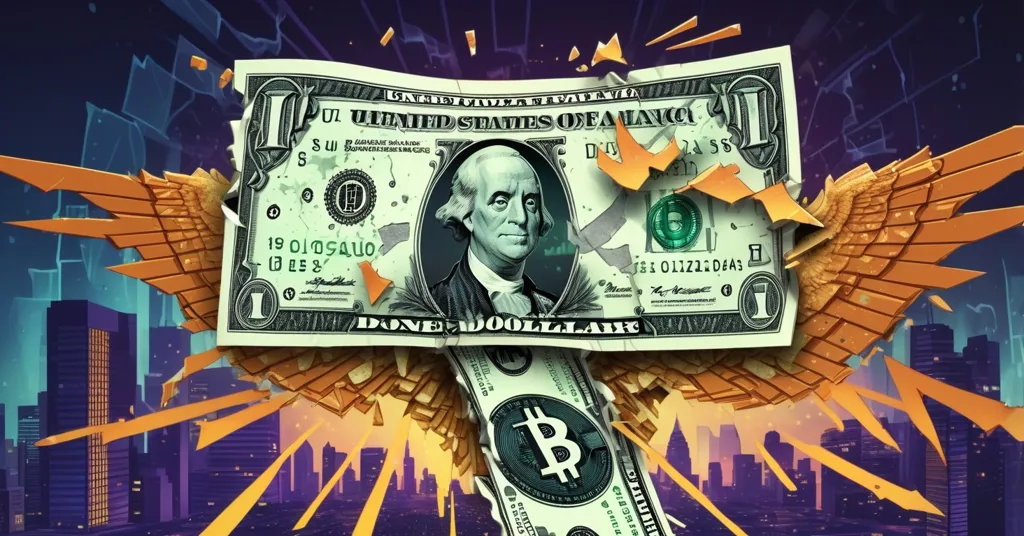U.S. Dollar Plummets in 2025: Is This Bitcoin’s Breakthrough Moment?

U.S. Dollar Decline 2025: Institutional Bearishness Signals a Bitcoin Breakthrough?
The U.S. dollar, once the unassailable titan of global finance, is taking a beating in 2025, with institutional investors betting big against it. A staggering 9.5% year-to-date drop—its worst performance in 30 years—has sparked serious doubts about fiat’s future, potentially paving the way for Bitcoin and decentralized systems to step into the spotlight.
- Historic Slump: U.S. dollar down 9.5% YTD, the weakest in three decades, with institutional bearish positions at $47 billion.
- Currency Rivals Surge: Euro, Swiss Franc, and Japanese Yen up over 8-10% against the dollar.
- Bitcoin’s Window: Dollar weakness bolsters the case for Bitcoin as a hedge against fiat instability.
Setting the Stage: The Dollar’s Crumbling Dominance
For decades, the U.S. dollar has been the backbone of global trade and finance, a reserve currency wielded by central banks and governments to maintain control over economic systems. Its strength underpinned centralized power, often at the expense of individual freedom and privacy—key grievances for crypto advocates. But now, with a historic decline unfolding in 2025, the cracks in this monolith are impossible to ignore. Data from the Commodity Futures Trading Commission (CFTC) reveals institutional investors holding net bearish positions of $47 billion against the dollar as of May 27, a level nearing the peak seen in December 2023. For the uninitiated, net positions reflect the difference between bets for and against an asset, and this figure signals a resounding lack of faith from the biggest financial players. Could this be the moment decentralization advocates have been waiting for?
Why the Dollar’s Sinking Fast
The greenback’s brutal 9.5% crash in 2025 isn’t just a number—it’s a wake-up call. Several forces are conspiring to drag it down, starting with a faltering U.S. labor market. Jobless claims have climbed for two straight weeks, and nonfarm payrolls—a key measure of job creation across most sectors excluding farming—are expected to show a measly 130,000 new jobs, down from April’s 177,000. The unemployment rate is projected to hold at 4.2%, hardly a sign of robust growth. When job numbers slump like this, it hints at an economy losing steam, spooking institutional investors who are showing bearish signs on the dollar.
Monetary policy adds fuel to the fire. With whispers of Federal Reserve rate cuts on the horizon—potentially multiple in 2025 if labor data stays weak—the dollar’s appeal as a high-yield currency diminishes. Lower interest rates mean less incentive for foreign investors to hold dollar-denominated assets, pushing them toward alternatives. Compare this to past crises like 2008, when dollar weakness stemmed from financial meltdowns, or the 1970s stagflation era of high inflation and low growth. Today’s mix of domestic slowdown and policy uncertainty feels like a modern remix of those dark days, and the market isn’t holding back its verdict, as seen in this economic analysis of the dollar’s 2025 decline.
Global Currency Power Shift
While the dollar stumbles, other currencies are sprinting ahead. The euro has soared 10.1% against the greenback in 2025, hitting a six-week high of $1.1473. Not to be outdone, the Swiss Franc and Japanese Yen have climbed 10.3% and 8.5% respectively. What’s behind this power shift? The European Central Bank (ECB), which oversees monetary policy for the Eurozone, cut interest rates by 25 basis points (that’s 1/100th of a percentage point, so a 0.25% reduction) on June 5, marking its eighth cut in a year. Yet, crucially, the ECB hinted at pausing further easing, signaling confidence in economic stability. This contrast with U.S. uncertainty has investors flocking to the euro, yen, and franc as relative safe havens, as detailed in this recent forecast on the euro-dollar exchange rate.
For those new to forex dynamics, currency strength often reflects trust in a nation’s economic health and policy clarity. When the dollar tanks, it’s not just a U.S. problem—it’s a signal to global markets that other fiat systems might offer more stability, at least for now. But here’s the kicker: even these “stronger” currencies are still fiat, subject to central bank whims. That’s a gap Bitcoin and crypto could exploit.
Geopolitical Wildcards and Trade Chaos
Zoom out to the global stage, and the picture gets messier. President Trump’s tariff bombshell on April 2, 2025, sent shockwaves through markets, with no clear resolution emerging from U.S.-China trade talks. A recent phone call between Trump and Xi Jinping yielded zero progress, leaving investors on edge. The UK stands as the lone outlier, securing a trade deal with the U.S. to dodge higher steel and aluminum tariffs, but for most nations, the uncertainty is a gut punch to confidence in U.S. assets. When trade wars flare, the dollar often bears the brunt as capital flees to less volatile regions, a point explored in discussions about the impact of Trump tariffs on dollar value.
Financial giants aren’t sugarcoating it. Bank of America Global Research, a heavyweight with trillions in assets under management, laid out the stakes:
“We remain bearish on the dollar but recognize this is becoming an increasingly consensus view, posing risks. Upside USD risks: ongoing U.S. data resilience, further cooling trade tensions, and Congress finding fiscal ‘sweet spot.’ We remain core dollar bears, but near-term upside risks cannot be ignored.”
Trader Andressa Mendes, echoing Morgan Stanley’s outlook, doubles down with a brutal assessment:
“The dollar’s in trouble — rate cuts, weak US growth, and Trump’s chaotic trade/tax moves are dragging it down. Morgan Stanley sees DXY -9%, EUR at 1.25, JPY at 130. Goldman flags tax risks for foreign investors. Bias: Bearish USD | Bullish EUR, JPY, AUD.”
Short-term, there’s a sliver of hope for the dollar. If U.S. economic data surprises with resilience—say, a stronger-than-expected jobs report—or if trade tensions cool with a surprise China deal, we could see a temporary rebound. Heck, if Congress somehow crafts a balanced budget plan that boosts growth without ballooning debt, the greenback might catch a breather. But hoping for policy miracles in 2025? You’ve got better odds spotting Bigfoot at a blockchain meetup.
Lessons from History: Fiat Falls, Alternatives Rise
This isn’t the first time the dollar has taken a nosedive, and history offers clues on what happens next. During the 2008 financial crisis, the greenback weakened as trust in traditional systems crumbled, driving investors to gold as a safe haven. In the 1970s, stagflation crushed fiat value, again pushing capital to tangible assets. Fast forward to 2020-2021, when dollar softness amid pandemic uncertainty coincided with Bitcoin’s meteoric rise—surging from under $10,000 to over $60,000 as institutional interest exploded. The pattern is clear: when fiat falters, alternatives shine, a trend well-documented in the historical record of the U.S. dollar’s decline.
Today’s 9.5% drop mirrors those past shocks but with a twist—geopolitical trade chaos and monetary divergence add layers of unpredictability. Back then, Bitcoin was a niche experiment or speculative gamble for most. Now, with broader adoption and infrastructure like ETFs, it’s positioned as a legitimate contender. The question isn’t just whether history will repeat, but how much louder the echo will be.
Bitcoin’s Big Break?
Here’s where it gets electrifying for our crypto crowd. The dollar’s freefall isn’t just fiat’s funeral—it’s a red carpet for Bitcoin to strut its stuff as “digital gold.” With a fixed supply of 21 million coins, Bitcoin stands immune to the endless printing presses of central banks, a stark contrast to the dollar’s devaluation spiral. When currencies bleed value, investors hunt for hedges outside government control—gold has played that role for centuries, but Bitcoin’s decentralized nature and portability make it a 21st-century rival. During the 2020-2021 dollar slump, Bitcoin’s price skyrocketed as institutions like MicroStrategy and Tesla piled in. Are we on the verge of a similar rally, especially given the current impact of dollar weakness on Bitcoin?
On-chain metrics add weight to the hype. Active Bitcoin wallet addresses have grown steadily through economic turbulence, signaling rising retail and institutional interest. Real-world use cases—like remittances in countries with crippled fiat systems (think Venezuela or Zimbabwe)—highlight Bitcoin’s utility as a lifeline when traditional money fails. Unlike dollar-pegged stablecoins such as USDT or USDC, which wobble with the greenback’s fate, Bitcoin operates on its own terms, a beacon for those fed up with centralized meddling. For Bitcoin maximalists like myself, this smells like vindication: the dollar’s pain is our gain, a step toward a world where financial freedom isn’t just a slogan, as discussed in perspectives on Bitcoin as a hedge against fiat decline.
But let’s not chug the hopium straight from the keg. Bitcoin’s volatility—think 50% crashes in past bear markets—makes it a questionable “safe haven” for jittery investors compared to gold’s relative stability. And while dollar weakness boosts the narrative, it doesn’t guarantee mass adoption overnight. The path to mainstream acceptance is a minefield, and we’d be fools to pretend otherwise.
Altcoins and DeFi in the Mix
Bitcoin isn’t the only game in town, and pretending it is would be intellectual laziness. Ethereum and decentralized finance (DeFi) protocols like Uniswap or Aave could carve out serious territory amidst this fiat mess, especially as trade wars disrupt cross-border payments. DeFi offers trustless, blockchain-based financial tools—think lending or swapping assets without banks—that sidestep the dollar’s woes entirely. Ethereum’s smart contracts enable complex transactions Bitcoin wasn’t built for, filling niches like decentralized exchanges or yield farming that could thrive when traditional systems stutter, a dynamic explored in conversations about how dollar decline affects crypto adoption.
Europe’s relative stability with the euro might even fast-track DeFi adoption there, as businesses and individuals seek alternatives to global fiat volatility. Altcoins aren’t just sidekicks; they’re part of a broader mosaic in this financial revolution, addressing use cases Bitcoin might never (and perhaps shouldn’t) touch. While I lean toward Bitcoin’s purity as a store of value, ignoring the innovation in altcoin ecosystems would be as shortsighted as dismissing the internet in 1995. Each piece of the crypto puzzle has its role—let’s not force a one-size-fits-all fantasy.
Regulatory Storm Clouds and Risks
Before we start chanting “Bitcoin to the moon,” let’s face the ugly reality: fiat’s desperation could spell trouble for crypto. Trump’s unpredictable policies might not stop at tariffs—capital controls or anti-Bitcoin measures like transaction taxes or wallet bans aren’t far-fetched if policymakers scramble to prop up the dollar. Look at China’s 2021 mining crackdown, which tanked hash rates temporarily, as a reminder that governments don’t play nice when threatened. Stablecoin users, tied to dollar pegs, could also get burned if trust in the greenback erodes further, exposing vulnerabilities in assets like USDT.
Playing devil’s advocate, is Bitcoin even a reliable hedge? Its wild price swings make gold look like a snooze fest by comparison. And let’s not forget the scams—every fiat crisis brings out shills peddling “$1M Bitcoin by Christmas” nonsense. Stick to fundamentals, folks; don’t fall for fairy tales. The road to decentralization is paved with promise, but it’s also littered with potholes. Eyes wide open.
What You Need to Know: Key Questions Answered
- What’s fueling institutional bearishness on the U.S. dollar?
A historic 9.5% YTD decline, shaky labor market data, potential Fed rate cuts, and Trump’s erratic trade policies are driving big players to bet against the greenback. - How are rival currencies performing against the dollar?
The euro, Swiss Franc, and Japanese Yen are crushing it with gains of 10.1%, 10.3%, and 8.5% respectively in 2025, as trust in the dollar fades. - Is Bitcoin poised to capitalize on the dollar’s 2025 collapse?
Yes, its decentralized, fixed-supply nature makes it a strong contender as a hedge against fiat devaluation, echoing rallies during past dollar slumps like 2020-2021. - What risks could derail crypto’s gains amidst fiat turmoil?
Regulatory crackdowns, stablecoin vulnerabilities tied to the dollar, and Bitcoin’s own volatility could throw wrenches into the narrative of crypto as a safe haven. - Should we doubt a total dollar meltdown?
Absolutely—short-term boosts from strong U.S. data or a surprise trade deal could prop up the dollar temporarily, so don’t bury it just yet. - Can altcoins and DeFi play a role in this financial shift?
Definitely, Ethereum and DeFi protocols offer solutions for cross-border trade and finance that Bitcoin doesn’t cover, potentially thriving as fiat systems falter.
The U.S. dollar’s hemorrhage in 2025 is a glaring reminder of fiat’s fragility when policy blunders and global tensions collide. For Bitcoin enthusiasts and decentralization diehards, this feels like a rallying cry—a chance to accelerate the shift to a freer, privacy-first financial future. But it’s no straight shot; regulatory landmines and market skepticism lurk. Should we root for fiat’s fall, even if it means short-term pain, to hasten blockchain’s rise? That’s the gamble of effective accelerationism. Stick around as we track this financial cage match—the stakes couldn’t be higher.



